Agrarwirtschaft 56 (2007), Heft 7
Figure 4. Parameterisation of EU co-financing and lump-sum
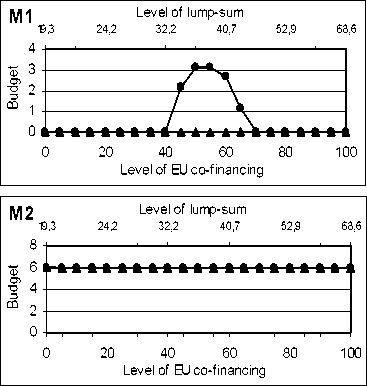
M6 Level of lump-sum
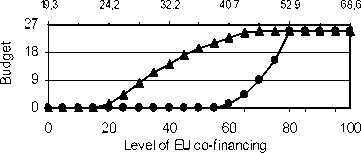
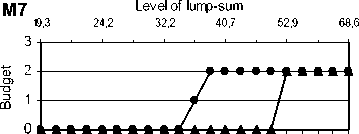
0 20 40 60 80
100
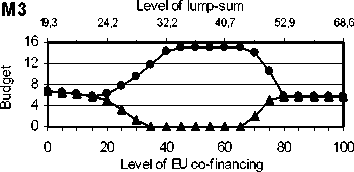
19,3
Level of EU co-financing
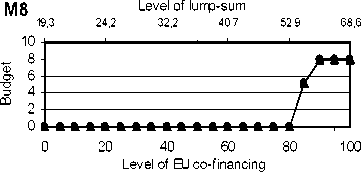
M4
Level of lump-sum
24,2 32,2 40,7 52,9
68,6

20 40 60 80 100
Level of EU co-financing
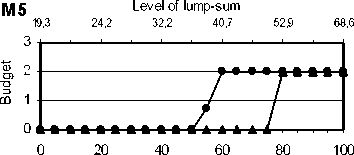
M1 General extensive grassland use
M2 Specific extensive grassland use - sheep
M3 Specific extensive grassland use - cattle
M4 Organic farming
M5 Special cultures
M6 Management of grassland
M7 Management of ancient orchards
M8 Management of cropland
M9 Management of set aside land
Level of EU co-financing
—•—Budget volume (mio. €) subject
to the level of EU co-financing (%)
Source: own calculations
M9
19,3
Level of lump-sum
24,2 32,2 40,7 52,9 68,6

0 20 40 60 80 100
Level of EU co-financing
—A— Budget volume (mio. €) subject
to the level of EU lump-sum (mio. €)
financing level from about
20% to 80%, the budget is
raised to the upper bound of
15 Mio. €.
In order to analyse the inter-
relations between the meas-
ures more closely, figure 5
illustrates the parameterisa-
tion of the EU co-financing
level and of the correspond-
ing lump-sum scenario of
selected measures within one
diagram. M2, M4, M8, and
M9 are not displayed in this
figure, as there is no differ-
ence in the budgets measures
between the co-financing
and the lump-sum scenario.
The budgets of the remain-
ing five measures are repre-
sented in per cent of the
respective upper bounds.
For the co-financing sce-
nario, the figure shows a
clear trade-off between the
VNS measure M6 on the one
hand and the MSL measures
M1 and M3 on the other
hand in the range of about
55% to 80% of EU co-
financing level. Starting
from a 55% EU co-financing
level, with increasing exter-
nal funding M3 is substi-
tuted by M6. For M5 and
M7 there is no trade-off with
respect to the other measures
and between the measures
themselves and the picture is
more simple. As discussed
for figure 4, these measures
switch from zero to a 100%
financing level at around
50% EU co-financing.
The results of the lump-sum
parameterisation also show a
clear trade-off between M6
For the measures M1, M3, M5, M6, and M7 there is a dif-
ference in funding between the co-financing and the lump-
sum scenarios. M5 and M7 are not financed for lower
budget volumes in both scenarios. They switch to the upper
bound above about 50% EU co-financing level, whereas the
same switch occurs under lump-sum scenarios only at
higher financial volumes. The figure shows a similar pic-
ture for M6. Therefore, for these measures the multi-level
co-financing system increases the incentives at lower budg-
ets. With respect to M1 and M3 these measures would not
be financed at all (M1) or at lower levels (M3) under the
lump-sum scenarios, whereas they receive a considerable
priority under the co-financing scenarios for specific co-
financing levels. M1, thus, receives a budget between about
40% and 70% of EU co-financing. For M3, from a EU co-
and M3 but this trade-off already occurs at lower financial
volumes. M6 starts to be financed with a total financial
budget of about 22 Mio. € and above. When the measure
reaches its upper bound at a total financial volume of about
45 Mio. €, M3 starts to be financed again and M5 and M7
are financed as well.
In order to analyse to what extent the multi-level co-financing
system distorts the financing of measures as compared to an
equivalent lump-sum scenario, figure 6 displays the values
of the objective function for both scenarios at different co-
financing levels and lump-sum financial volumes respec-
tively.
As can be seen in figure 6, the values of the objective func-
tion are lower under the co-financing scenario than under
302
More intriguing information
1. Pricing American-style Derivatives under the Heston Model Dynamics: A Fast Fourier Transformation in the Geske–Johnson Scheme2. Improvements in medical care and technology and reductions in traffic-related fatalities in Great Britain
3. The name is absent
4. Midwest prospects and the new economy
5. The name is absent
6. ‘I’m so much more myself now, coming back to work’ - working class mothers, paid work and childcare.
7. INTERACTION EFFECTS OF PROMOTION, RESEARCH, AND PRICE SUPPORT PROGRAMS FOR U.S. COTTON
8. The name is absent
9. The name is absent
10. MULTIPLE COMPARISONS WITH THE BEST: BAYESIAN PRECISION MEASURES OF EFFICIENCY RANKINGS